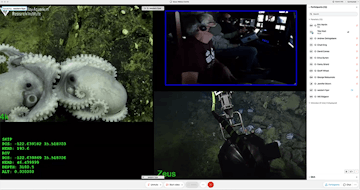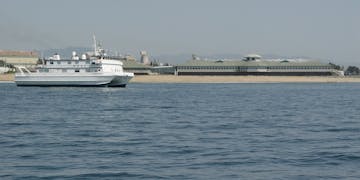Since its founding, MBARI has endeavored to share its unique ocean research, exploration, and technology mission as broadly as possible. Early on, MBARI began to cultivate a vision for using microwave technology to connect the profound deep-sea research conducted on our ships to audiences at the Monterey Bay Aquarium. This effort came to be known as the “Live Link,” and it was used by the Aquarium, in varying forms, for almost three decades until it was finally retired in 2016.
Science push
This year, as the pandemic imposed strict limits on the number of people that could be aboard our research vessels, MBARI found itself in need of a “Live Link” once again. This time, the need for telepresence capabilities was further motivated by the fact that scientists worldwide were unable to go to sea with us and needed new ways to conduct their research remotely.

Telepresence gives researchers access to live video from the ROV, as well as data and audio connectivity to interact with the scientists and ROV pilots aboard the ship. Image: © 2020 MBARI
With that goal in mind, a small team of MBARI technicians, engineers, and researchers started discussing how to maximize the efficacy of offshore operations while adhering to the new restrictions imposed by COVID-19. Drawing on experience and discussions with experts, they determined that a more compact telepresence solution could be built to fit within the limited telecommunications capabilities of both the R/V Western Flyer and R/V Rachel Carson. As MBARI returned to offshore operations, a request was approved to begin designing and testing prototype systems that would integrate both vessels and all three remotely operated vehicle systems to provide telepresence capabilities for displaced science and technical members. The system was in operation one month later.
Since July 2020, the team has supported 44 days of telepresence-enabled science on MBARI research vessels. We utilized a virtual link on four Western Flyer expeditions, including dives with principal investigators Bruce Robison, David Caress, Jim Barry, and a three-week continuous deployment during the northwest expedition led by Charlie Paull.
Aboard the Rachel Carson, we have enabled collaboration with the Aquarium and maintenance at our offshore observatory, known as MARS. The Rachel Carson work supported many more researchers’ ongoing efforts, including Kakani Katija and Ken Smith. Telepresence has helped solidify our collaborations with many organizations, including the USGS, NOAA NMS, BBC, BOEM, Stanford University, MLML, IFREMER, and others. We have brought participants "on board" from locations as remote as the United Kingdom and Chile—in both cases, those attendees were allowed to remotely direct operations happening in real time.

Outreach pull
This new telepresence capability has presented an exciting outreach opportunity—a chance to revisit the “Live Link” concept and update it for the age of social media. In 2021, ITD will be collaborating with researchers and marine operations staff to produce two ship-based livestream events from the Western Flyer for classrooms and the general public. The focus will be on MBARI’s ongoing research efforts at Sur Ridge and will contain a mix of live video footage captured by MBARI’s ROV Doc Ricketts as well as pre-produced content.
Looking ahead, MBARI is excited to invest in new ways to achieve our ship-based research virtually. Designing a compact system that will operate inside of more common commercial satellite systems can transform how we communicate our ocean discoveries to a broader audience and increase productivity for many oceanographic research vessels in the future.
